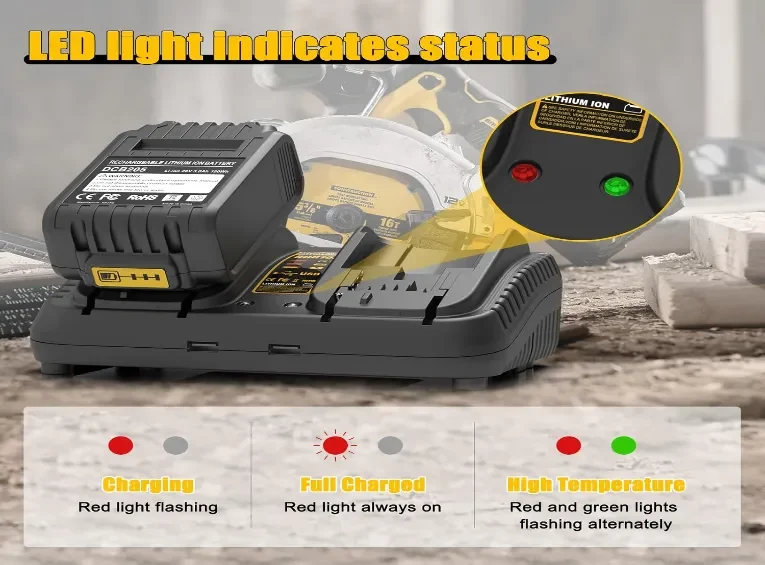DeWalt Charger LED Signals — Pro Diagnostic Guide
On a busy job site, every minute counts. LEDs communicate battery and charger status instantly. Correctly reading these signals prevents downtime, identifies unsafe conditions, and ensures fleet reliability. This guide is model-agnostic and shows LED meanings, fast diagnostics, swap tests, and SOP language used by professional crews.

Quick Cheat Sheet
No light = no power; solid red = charging; solid green = charged/standby; slow red flash = temperature/wait; fast red flash = battery/ID fault; alternating red/green = conditioning/handshake; rapid/odd flashing = charger fault — act accordingly.
LED Patterns, Meanings & Immediate Actions
| LED Pattern | Meaning | Pro Action |
|---|---|---|
| No light | No power / charger dead | Check outlet, reset GFCI, inspect cord; tag if still unresponsive |
| Solid red | Charging (CC phase) | Monitor battery temp (<45 °C); log charge duration; do not leave unattended in extreme heat |
| Solid green | Charge complete / float | Safe to remove; if instantaneous green → perform load test |
| Slow red flash | Temperature wait | Warm cold packs 30–60 min or cool hot packs 10–20 min; clean contacts |
| Fast red flash | Battery / ID fault | Clean contacts, reseat, wait 1–2 min; swap test; quarantine if repeat |
| Alternating red/green | Conditioning / handshake | Wait 10–30 min; if stuck, swap test; do not force charge |
| Rapid / odd flash | Charger fault / internal error | Unplug, tag for service, use backup unit |
Fast Diagnostic Workflow (1–2 Min)
-
Safety check — smoke, swelling, extreme heat → isolate immediately.
-
Power check — verify outlet and GFCI; confirm charger LED with no battery inserted.
-
Contact cleaning — wipe battery rails and terminals with isopropyl alcohol.
-
Swap test — confirm which unit (battery or charger) is faulty.
-
Optional multimeter check — measure open-circuit voltage for suspicious packs.
-
Log & act — retire, repair, or quarantine the defective component.
LED + Symptom Quick Map
-
No LED, outlet OK → charger input/fuse fault.
-
Solid red, long charge time → aging battery or high ESR capacitors.
-
Fast red flash + hot pack → possible internal cell issue → quarantine battery.
-
Alternating LEDs stuck → handshake/ID mismatch → swap test; quarantine if persistent.
Tools Pros Should Carry
-
Digital multimeter
-
Isopropyl alcohol ≥70% + lint-free swabs
-
IR thermometer
-
Known-good OEM charger or verified backup
-
Incident log template (battery ID, charger ID, LED pattern, action)
Fleet SOP Snippets
-
Pre-shift: inspect chargers, confirm LEDs, tag non-responsive units.
-
Charging area: ventilated, non-combustible, one-pack-per-bay.
-
Quarantine: repeated fast-flash faults → “QUARANTINE,” log pack ID/date/symptoms.
-
Emergency: smoke/flame → evacuate, call services; minor incidents → isolate pack outdoors, document.
Retire vs Repair
-
Retire battery: swelling, leakage, persistent BMS lockouts, extreme sag, fire/smoke.
-
Repair charger: replaceable external parts (cord, fuse, springs) or certified internal repair; replace if PCB/SMPS fails.
When Diagnosis Points to Hardware Fault — Brand Solution
If “known-good” testing confirms failure, replacement is faster and safer than repair. Downtime costs money. XNJTG provides professional-grade DeWalt-compatible chargers and batteries that replicate OEM protocols without the OEM price.
Advantages:
-
Reliable LED behavior and protocol accuracy
-
Tested compatibility and safety
-
Fast delivery for jobsite continuity
[Link to compatible chargers] | [Link to compatible batteries]
Conclusion
LEDs are the jobsite’s early-warning system. Quick interpretation, swap testing, and consistent logging maximize uptime and safety. Equip your team with reliable gear and clear SOPs to reduce risk and improve fleet performance.
FAQ
Q: Charger shows solid red for hours, battery cold — what’s wrong?
A: Likely a failed battery. Swap-test with a known-good charger to confirm.
Q: Is a yellow light always safe?
A: Indicates recovery mode; may revive aging batteries, but frequent triggers = pack nearing end-of-life.
Q: Do aftermarket chargers mimic OEM LEDs?
A: Yes, if certified. Our chargers replicate DeWalt protocols for seamless diagnostics and safety.